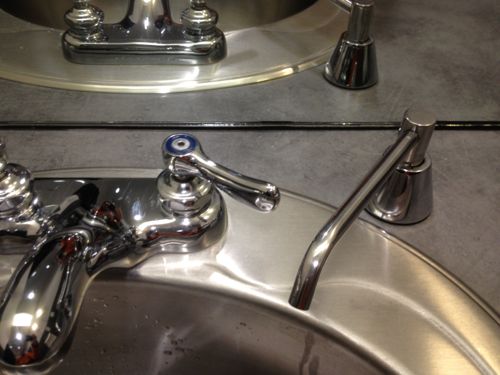The ADA, Design Professionals, and Soap Dispensers
The Americans With Disabilities Act (ADA) of 1990 has many standards for design professionals to use when designing everything from public streets to stadiums to public bathrooms. It doesn’t seem to require a soap dispenser usable only with one hand.

I see this type of dispenser way too often, if it’s really short I can use it one handed. Most of the time I have to wash my hand without soap. Someone continues to select this dispenser even though not everyone can use it. I can’t find an ADA requirement that a dispenser be able to be used with one hand.
The point? Regulation isn’t perfect. Designers must think, not just meet the minimum requirements.
— Steve Patterson
Agree. Where I work, we have motion-activated faucets and dispensers, which seems to be a pretty good (and more sanitary) solution, along with motion-activated flush valves and towel dispensers (no touching – a good thing).
The problem isn’t with design or regulation it is with time. For instance when ADA was implemented many things such as the motion sensor dispensers were not invented yet. Then when this modern stuff comes out, there is the cost of such. You would think something like this soap dispenser would be cheap but far from it. Those plastic ones on the walls? They can run as much as $50 to $100 each and that is just the device, not installation. And they didn’t come about because of the ADA either but because of the bird flu virus a few years back when hosptials were looking for ‘no-touch’ solutions for their staff….i.e. a market. Add to that the delay, usually of years, before things get regulated or as some would say “updated” those regultations. Sadly we can’t just snap the fingers and whoa motion soap dispensers everywhere.
Regulation is far from perfect. It (like the ADA) was never meant to be the cover all possibilities and be over-regulated. There is that whole how much should goverment regulate arguement (soap dispensers or gun ammo??) Too many people say don’t regulate my stuff….just everyone elses. But that is a different argument so lets not go off on a tangent folks. The point is that Steve is right that designers should lead, and educate the builders/buyers. Key word: educate.
Why should they spend the money on motion dispensers (or anything else for that matter)? Many of these things are expenses….that is they cost to put in, but there is no return…they don’t make direct money for the owner. Key word: direct.
Educate the owner to the benefits of why these things are important.
Uh, the ADA aws implemented in the 1990s. There have been motion sensors for decades before that.
Yes, and the ADA does not require motion sensors. The ADAAG defines acceptable reach ranges and operation effort. Motion activated devices are one solution, as are more traditional mechanical (pump and lever operated) devices. Motion activated devices cost more money, require more maintenance (batteries) and are far from perfect (don’t operate when the power fails, are not easily adjustable for temperature / mixing variable hot and cold supplies).
Actually no they haven’t been around for broad commercial use for that long. And duh…..this is a traditional pump device. More tradtional than wall mounted.
seldom are people who work in ADA designs, compliance , or anything else to do with disabled people, actually disabled. check it out for yourself.
And your point is? One needs to be disabled to fully understand the challenge(s)? Or that only someone with a disability is capable of designing an appropriate solution? As an architect who has completed multiple accessibility compliance surveys and prepared multiple modification plans, I’d argue that the biggest hurdle lies on the owner and tenant side, not on the consultant side. When an owner or tenant is advised to spend additional money on better accessibility, it usually boils down to the direct cost and the building code, it becomes a business decision. If “most” of their clients, customers or employees won’t benefit from the modifications, there’s push back. If the building code doesn’t explicitly require something, there’s push back. Add in that many owners and tenants equate accessibility with just wheelchairs, and you end up with many other disabilities (like stroke and arthritis) being ignored completely. And all of this is complicated by the fact that the ADA is civil rights legislation, enforced on a case-by-case, complaint-driven process, not by consistent inspections from local officials, like health, building and fire codes are, so buildings are allowed to open with, sometimes, significant barriers and continue to operate with the barriers in place for years or decades. Hiring the disabled to perform these tasks, while a noble goal, will do little to change the real-world outcomes if the ones with the money choose not to / are not forced to implement better solutions . . . .
Being disabled would certainly make the design more aware. The “completed multiple accessiblity compliance surveys and prepared multiple modification plans…..” is just a cute way of saying It’s not my fault. The biggest hurdle isn’t on the owner/tenant side but on BOTH sides. Sorry but architects have a duty to do more than just layout plans. Educating the owners and tenants about the reasons for such things as ramps, doors, soap pumps, etc would go a long way to correcting many of these problems. And by educating, I mean more than “it’s the law, that’s why”.